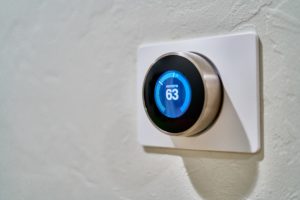You chose your heating and air conditioning system with the intention of conserving energy, saving money, and keeping your home comfortable. But your system, whether it’s new or old, only works within the settings you choose.
Unfortunately, this responsibility means that many homeowners’ HVAC systems fall short of their optimized performance levels.
In this blog, we provide good general practices for setting your thermostat, as well as seasonal recommendations to help you get more out of your system.
Best Practices
In our previous blog, “Conserve Heat in Your Home to Lower Your Energy Costs and Environmental Impact,” we advocated for investing in a programmable thermostat to simplify the way you heat your home. However, even a programmable thermostat only works at its highest capabilities when you understand how to use it.
Whether you have a programmable model or must input your thermostat settings manually, follow these best practices:
- Alter your settings when away. If possible, keep your home at its most energy-efficient temperature for at least eight hours each day. You may choose to schedule these eight hours for when you’re at work to avoid any discomfort.
- Familiarize yourself with your thermostat model. Read your user manual and follow thermostat model recommendations for best results.
- Make seasonal changes gradually. Adjust your temperature settings a degree or two at a time to avoid wasting energy. If you have strong sensitivities to temperature change, initially set your thermostat at the most comfortable temperature and then gradually work toward recommended settings. Or, if you can do so comfortably, start at the farthest end of the suggested temperature spectrum and change settings until you find one that fits your lifestyle and comfort levels.
If you notice frequent issues with your thermostat, consider upgrading to a new model. Disconnects between your thermostat and your HVAC systems can create a number of complex problems for climate control.
Summer Settings
 When temperatures spike, it’s tempting to crank up the air and maintain the temperature you’ve become accustomed to. However, to keep your air conditioner running efficiently in the summer, you should use the following settings:
When temperatures spike, it’s tempting to crank up the air and maintain the temperature you’ve become accustomed to. However, to keep your air conditioner running efficiently in the summer, you should use the following settings:
Set your thermostat at 85 degrees Fahrenheit, or turn the unit off while your house is empty.
Set your thermostat between 75 degrees and 78 degrees while you’re at home and awake.
If comfortable for your family, increase your thermostat temperature during the night to reduce the strain on your system.
If you have a programmable thermostat, schedule your settings to change about the same time that your family wakes up in the morning, then again when you leave the house for work, return home, and turn in for the night.
Winter Settings
Few settings feel as inviting as a toasty home after spending time out in the cold. To keep yourself warm without spending a fortune on heating, follow these guidelines:
- Set your thermostat at 55 degrees, or turn it off while your house is vacant.
- Set your thermostat for 62 degrees to 66 degrees during sleeping hours.
- Set your thermostat for 68 degrees to 72 degrees while your family is home.
Consider setting your thermostat at its highest temperature for when you first get home at the end of the day and decreasing the settings as you adjust in the evening. Your programmable thermostat can make this change automatically over the course of a few hours or you can change the settings by hand as you feel comfortable.
Follow these guidelines to keep your home at its most comfortable throughout the entire year.
Not seeing the performance that you want from your heating or air conditioning system? Have a technician from Glendale Heating and Air Conditioning evaluate your units. We can help you improve the performance of your current system and decide when it’s time to upgrade.

